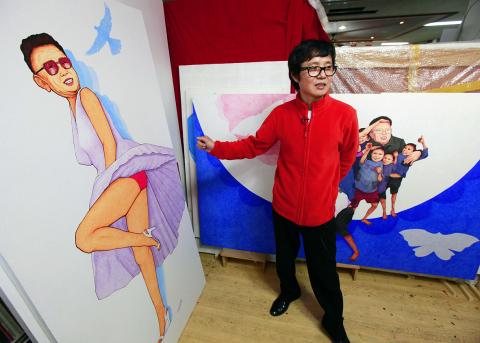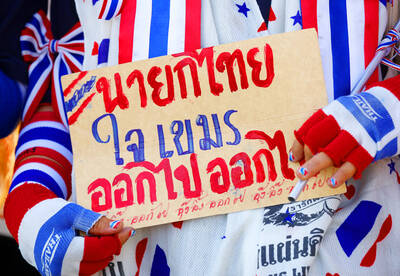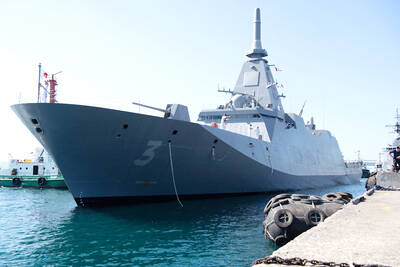Above the ballooning dress of Marilyn Monroe is the face of the late North Korean leader Kim Jong-il. A pigeon flies overhead and a feather lies nearby on the ground.
North Korean artist Song Byeok once proudly drew the “Dear Leader” in propaganda paintings, but he was sent to labor in one of the reclusive state’s notorious prisons after hunger forced him to try to flee.
Now a defector living in Seoul, South Korea, Song has turned to mocking a ruler who led his country into famine, isolation and economic ruin.

Photo: Reuters
“The day I finished this, he passed away,” Song said of his painting and the death of Kim on Dec. 17.
“He’s not an eternal creature, but the same as the feather of a pigeon,” Song said, using the feather to symbolize something inconsequential. “I thought it would’ve been better if he made North Koreans better off and forget hunger before he died.”
Kim, who was 69 when he died, was a patron of the arts in his hermit kingdom and at times went to extreme means to promote the arts.
He once kidnapped a South Korean film director and forced him to make movies for him. Kim amassed a big hoard of South Korean movies on DVD and commissioned works of art.
Song never had a sitting with Kim, the second member of a dynasty that has ruled North Korea since its birth in 1948.
Every morning, he was handed a sketch of whatever piece of propaganda the state wanted illustrated that day.
“How could I, just a commoner, meet Kim Jong-il? He is the sun,” the 42-year-old painter and sculptor said.
Song, like most other North -Koreans, practically worshiped Kim and before that, his father, North Korean founder Kim Il-sung.
However, starvation, a result of chronic mismanagement and natural disasters, changed that. After floods in the late 1990s, conditions deteriorated to the point of desperation.
In August 2000, Song and his father, driven by hunger, tried to swim across the Tumen River to China in the hope of getting food from relatives there.
However, his father was swept away in the swollen river and Song was caught and sent to a labor camp, the North Korean equivalent of the Soviet-era gulags, where the human rights group Amnesty International says 200,000 people are forced to work with little food and under threat of execution.
In the freezing Korean winter, Song recalls he was as lightly dressed as when he was arrested in summer.
A finger on his right hand became infected and eventually he says he was so close to death that his captors could get no work out of him and released him.
However, Song was determined to try to get out and in 2002, leaving his mother and sister behind, he made it and ended up in Seoul. After his mother died in 2005, he brought his sister and her family out in 2007 with the help of a broker in China.
“If we had had enough to eat, I would have not come,” Song said.
Despite losing his finger, Song took up his brush again. Some of his paintings now show hollow-eyed North Korean girls and smiling, homeless children, known in the North as “fluttering swallows,” surrounding Kim Jong-il.
As for “Great Successor” Kim Jong-un, Song said that for now, he has no plan to paint him.
“He’s too young and I don’t want to say yet,” Song said.

Eleven people, including a former minister, were arrested in Serbia on Friday over a train station disaster in which 16 people died. The concrete canopy of the newly renovated station in the northern city of Novi Sad collapsed on Nov. 1, 2024 in a disaster widely blamed on corruption and poor oversight. It sparked a wave of student-led protests and led to the resignation of then-Serbian prime minister Milos Vucevic and the fall of his government. The public prosecutor’s office in Novi Sad opened an investigation into the accident and deaths. In February, the public prosecutor’s office for organized crime opened another probe into

RISING RACISM: A Japanese group called on China to assure safety in the country, while the Chinese embassy in Tokyo urged action against a ‘surge in xenophobia’ A Japanese woman living in China was attacked and injured by a man in a subway station in Suzhou, China, Japanese media said, hours after two Chinese men were seriously injured in violence in Tokyo. The attacks on Thursday raised concern about xenophobic sentiment in China and Japan that have been blamed for assaults in both countries. It was the third attack involving Japanese living in China since last year. In the two previous cases in China, Chinese authorities have insisted they were isolated incidents. Japanese broadcaster NHK did not identify the woman injured in Suzhou by name, but, citing the Japanese

YELLOW SHIRTS: Many protesters were associated with pro-royalist groups that had previously supported the ouster of Paetongtarn’s father, Thaksin, in 2006 Protesters rallied on Saturday in the Thai capital to demand the resignation of court-suspended Thai Prime Minister Paetongtarn Shinawatra and in support of the armed forces following a violent border dispute with Cambodia that killed more than three dozen people and displaced more than 260,000. Gathered at Bangkok’s Victory Monument despite soaring temperatures, many sang patriotic songs and listened to speeches denouncing Paetongtarn and her father, former Thai prime minister Thaksin Shinawatra, and voiced their backing of the country’s army, which has always retained substantial power in the Southeast Asian country. Police said there were about 2,000 protesters by mid-afternoon, although

MOGAMI-CLASS FRIGATES: The deal is a ‘big step toward elevating national security cooperation with Australia, which is our special strategic partner,’ a Japanese official said Australia is to upgrade its navy with 11 Mogami-class frigates built by Japan’s Mitsubishi Heavy Industries, Australian Minister for Defence Richard Marles said yesterday. Billed as Japan’s biggest defense export deal since World War II, Australia is to pay US$6 billion over the next 10 years to acquire the fleet of stealth frigates. Australia is in the midst of a major military restructure, bolstering its navy with long-range firepower in an effort to deter China. It is striving to expand its fleet of major warships from 11 to 26 over the next decade. “This is clearly the biggest defense-industry agreement that has ever